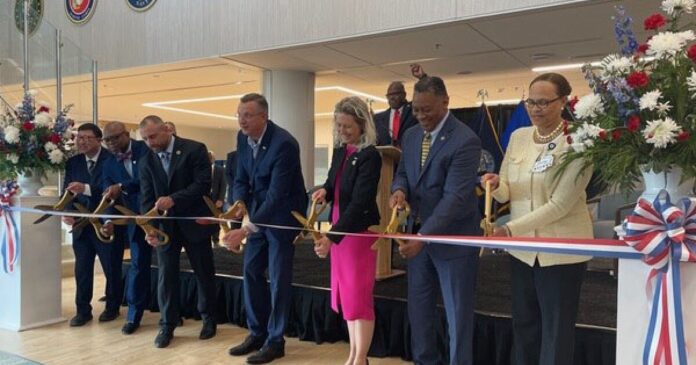When Veterans Affairs Secretary Doug Collins cut the ribbon this month for a new outpatient clinic in Chesapeake, Virginia, the event underscored the challenges facing the agency as it attempts to implement the Trump Administration’s spending cuts.
This part of Virginia has one of the fastest growing veteran populations in the country, and the clinic is opening with less than a third of the staff it needs to run at full capacity. Collins has said the VA will increase staffing in stages.
Still, the region hasn’t been spared from VA staff cuts. A dozen probationary workers were initially let go, while others have accepted buyouts. Collins has given the VA until August to cut 15 percent of its agency wide budget.
“It’s a goal,” Collins said of the cost cutting target. “It’s not mandatory. Nobody has said it’s got to be 15 percent. In fact, it may not actually get to 15 percent. But if we don’t set a target for actually doing a hard look at who we are, then nobody’s going to do anything.”
Collins laid out the cuts in March. With the help of the Department of Government Efficiency, the VA plans to eliminate more than 70,000 workers. Every local VA, including fast-growing ones like in Virginia, must compile a list of potential firings, known as a reduction in force.
The VA also is hoping to save millions of dollars by canceling contracts for things like software and consulting. Without providing documentation, Collins has gone around the country listing contracts that have been cut. The savings will be rerouted to patient care, he said.
But the Trump Administration has also talked about using the DOGE savings to pay for tax cuts. Elon Musk, the head of DOGE, has proposed sending out the money in checks to taxpayers.
In the end, Collins said he cannot guarantee that all the VA’s savings will remain in the VA budget.
“There is a lot of bloat in our government,” he said. “A lot of things that we shouldn’t be doing. That’ll be up to the President. I know one thing from the President. He’s actually said, ‘Doug, take care of my veterans.'”
The VA secretary said he isn’t working just with DOGE to create his VA efficiency plan. He said he’s also brought in people who worked in the VA during the first Trump Administration, as well as advisors who he said have decades of health care experience.
Steve Walsh / American Homefront
/
American Homefront
So far, though, he has not reached out to the independent Inspector General’s office, which investigates claims of waste, fraud and inefficiency. The VA inspector general was one of twelve fired by the Trump Administration. But the office is still issuing reports, including a recently released study of the Hampton VA, which includes the Chesapeake area. It pointed out that providers were volunteering to work Saturdays to keep patient wait times down.
“We’re hopeful that they would use our work to either support those decisions or to at least reach out to us to understand what our work might suggest with the implications of staffing cuts in various areas of VA,” said Dr. Julie Kroviak, Deputy Assistant Inspector General for Health at the VA.
While Collins’ team looks for cuts, the number of patients continues to increase, especially in the Hampton area. A third clinic is already planned for Chesapeake.
While the ribbon cutting was held inside the Chesapeake clinic, Damian Carr, a 26 year army vet, held up a sign outside calling on the VA to fully staff the facility.
“You’re going to lose the people that are providing the care, because you can’t hire them, because who wants to come for a job that they’re not sure about?” Carr said.
Carr said he’s been a patient at Chesapeake’s older VA clinic.
“It was always full, ” he said. “But they took care of me, and they still take care of me. I mean, if I took these hearing aids out, we wouldn’t be talking.”
At the Hampton VA, most of the twelve fired probationary employees have gone back to work after a judge’s order. According to their union, one worker turned down an offer to come back, saying he found a better job.
This story was produced by the American Homefront Project, a public media collaboration that reports on American military life and veterans.
Copyright 2025 American Homefront Project
